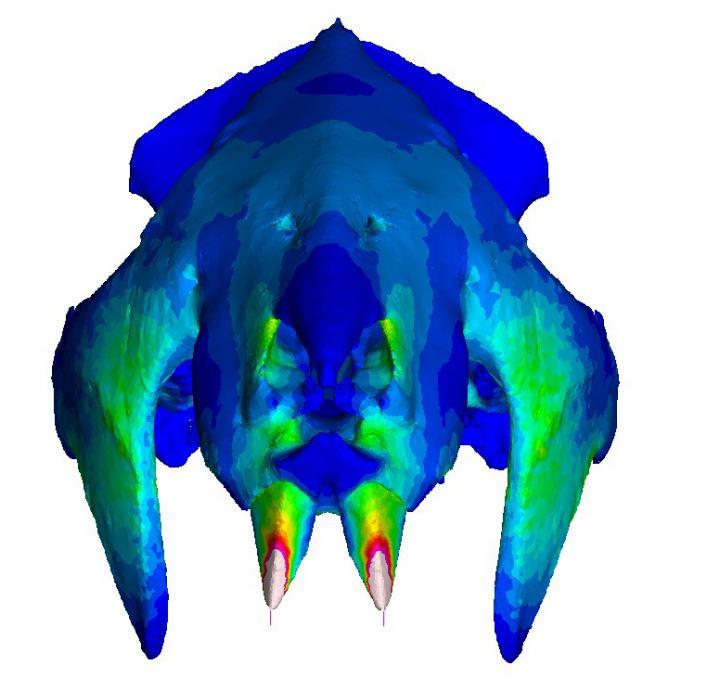AMHERST, Mass. – The surprise discovery of the fossilized skull of a 66- to 70-million-year-old, groundhog-like creature on Madagascar has led to new analyses of the lifestyle of the largest known mammal of its time by a team of specialists including biologist Elizabeth Dumont at the University of Massachusetts Amherst, an expert in jaw structure and bite mechanics.
The skull of this animal, named Vintana sertichi, was found in a geological formation deposited when a great variety of dinosaurs roamed the earth. With a skull that is almost five inches (125 mm) long, it was double the size of other mammals from the southern supercontinent, Gondwana, during the Age of Dinosaurs. The authors estimate a body mass of about 20 lbs. (9 kg). Findings appear in the current issue of Nature.
The well-preserved skull allows a wealth of insights into the life habits and relationships of early mammals of the Upper Cretaceous age, Dumont says. "My part in this huge interdisciplinary effort was to reconstruct the skull and model the mechanics of chewing and estimate the animal's ability to eat different kinds of foods."
Dumont and her assistant Dan Pulaski reconstructed the cranium from CT scans by painstakingly moving bone fragments back into place and filling in missing bone with mirror images of the same bone from the other side of the skull. Dumont reconstructed the chewing muscles based on comparison to living rodents and used engineering-based models to predict how the jaws moved and how hard the animal could bite.
Vintana's massive chewing muscles moved the jaw upward and backward and likely produced higher bite forces than living rodents of similar body size. Based on characteristics of its jaws and teeth and analyses by Dumont and others, the authors believe it ate a diet of roots, seeds or nut-like fruits.
Vintana belongs to a group of early mammals known as gondwanatherians, until now known only from isolated teeth and a few jaw fragments. The well-preserved skull allows the first clear insight into the life habits and relationships of gondwanatherians.

This image is a finite element analysis result, showing how stress is distributed through the skull under an incisor bite at a wide gape angle.
(Photo Credit: UMass Amherst)
Dumont and lead author, paleontologist David Krause of Stony Brook University, agree that the discovery shakes up evolutionary biologists' views of the mammalian "family tree." Krause says Vintana "reshapes some major branches" of that tree, grouping gondwanatherians with others that have been "very difficult to place." Dumont adds, "This work is a real tour de force thanks to the collaboration of many different specialists."
Krause also points out, "We know next to nothing about early mammalian evolution on the southern continents. This discovery, from a time and an area of the world that are very poorly sampled, underscores how very little we know. No paleontologist could have come close to predicting the odd mix of anatomical features that this cranium exhibits."
Krause and colleagues discovered the skull in 2010 by chance. It is only the third mammalian skull to be recovered from the Cretaceous in the Southern Hemisphere.
Specialists including Dumont conducted a comprehensive analysis of the skull using micro-computed tomography and scanning electron microscopy to reveal very small anatomical details in areas such as the braincase, nasal cavity and inner ear that are poorly known in nearly all early mammals. Dumont and colleagues compared the skull to those of hundreds of other fossil and extant mammals and concluded that it likely had large eyes, the ability to hear high frequency sounds and a good sense of smell.
With the addition of this new information on cranial anatomy of gondwanatherians, which was previously completely unknown, the researchers also explored its possible relationships to other early mammals. Their analysis is the first to find strong evidence that Vintana was probably closely related to multituberculates, the most successful mammalian contemporaries of dinosaurs on the northern continents, and early herbivores known as Haramiyida.
Madagascar had been an island for over 20 million years prior to the time in which the strata containing Vintana were deposited. The researchers theorize that the primitive and unusual features of its skull are holdovers from when the ancient landmass was cut off from Africa, Antarctica and Australia, and finally the Indian subcontinent.